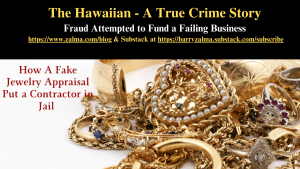The Hawaiian – A True Crime Story

Post 4867
See the full video at https://rumble.com/v5e5vml-httpsyoutu.bexfrzksp-lbq.html and at https://youtu.be/xFRzkSp_LbQ
This is a fictionalized True Crime Story of Insurance Fraud from an my career as a insurance coverage and insurance fraud Lawyer. The story is presented to help people Understand How Insurance Fraud in America is Costing Everyone who Buys Insurance Thousands of Dollars Every year and Why Insurance Fraud is Safer and More Profitable for the Perpetrators than any Other Crime.
The insured was a contractor in Honolulu. He made an excellent living cheating his customers. The insured’s most lucrative scheme was an electronic vermin killer. The device, charged with low voltage from the transformer, allegedly repelled vermin. When it didn’t work and a customer called to complain the insured would ignore the complaints.
The Attorney General eventually filed administrative charges accusing the insured of consumer fraud. His sales began to drop. He needed cash flow.
The insured went to the most exclusive jewelry store in all of Honolulu. The store occupied the 15th floor of a high-rise office building. To enter he needed to show identification to a guard and pass through two steel doors.
He bought a single wrist watch at the jeweler and charged it on his American Express card. He asked the jeweler for, and received, an appraisal of the wrist watch. He then visited the local public library and withdrew three textbooks on gemology.
He made a xerographic copy of the appraisal and covered the description of the wrist watch with a large Post-It Note. He photocopied 20 new copies of the appraisal. The Post-It-Note was invisible to the copymachine and he had clean appraisals with no descriptions.
Using the books on gemology, he wrote out descriptions for forty-five separate items of ladies and men’s jewelry. He set values beside each item so they totaled over $500,000.
Armed with his appraisals he visited a large retail insurance brokerage in Honolulu. He advised the broker that he had recently acquired the jewelry from his deceased mother and needed it insured. The insured selected the insurer that offered the lowest premium. He explained to his agent that he had a slight cash flow problem and the agent helped him by financing the premium.
He made one payment on the premium finance contract and then reported a theft.
He advised his insurer that the jewelry was secured in the locked drawer of his office which he considered to be a safe. His office was a small structure with a warehouse facility where he parked his construction truck and, on that night, the Ferrari. It was an employee’s birthday and he and five employees went to a local restaurant to celebrate the birthday. Since they could not fit in his Ferrari, they all went in his foreman’s eight passenger van.
When they returned from the birthday party, they immediately noticed that the Ferrari was no longer in the warehouse. The aluminum overhead door was off its track. Someone had broken in. He only wanted his family heirlooms back. He even asked his insurer to offer a reward for the return of the stolen jewelry.
Besides advising the investigator of the theft he informed him that his mother had mailed him the jewelry shortly before her death. He took them to the jewelry store to establish the value of the gift his mother had made to him. He was astonished that the jewelry had as great a value as reported by the jeweler. He immediately took steps to insure the jewelry.
The adjuster began the steps necessary to complete what might be a routine investigation. His first stop was at the jewelry store. He found the gemologist who signed the appraisal. He showed the appraisal to him and asked that he verify the appraisal. The jeweler stated:
“That is our appraisal form. That is a copy of my signature. I have no record of ever doing this appraisal. I have no recollection of ever doing this appraisal. I have no knowledge of the person with the name of the insured. That isn’t unusual however since I do one thousand appraisals a year.”
“Do you have your file copy?” the adjuster asked.
“That’s what is strange, I can’t find the file copy. But my secretary, just about the time of this appraisal began chemotherapy treatment for cancer. She’s dying and I can’t disturb her.”
The adjuster next had a friend who works the South Pacific attempt to verify that the insured’s mother did in fact live in the village in the Philippines described by the insured. The investigator was successful. He found neighbors and relatives who knew the insured’s mother. He could not, however, verify that she had $500,000 in jewelry to donate to her son. In fact, he found that the insured’s mother lived in a one room house on stakes with a grass roof, no electricity, no running water and no indoor plumbing. Her ex-husband still lived in Honolulu.
The adjuster invited the insured’s secretary out to lunch. Over a chef’s salad and a glass of iced tea he learned the secretary’s life story. After gaining her confidence the adjuster confronted the secretary with the result of his investigation. He told her that he liked her and would be very sorry if she was involved in aiding her boss in committing a crime.
She began to cry. The adjuster thanked her, paid for lunch and suggested she get a new job. He told her he would do what he could to keep her out of criminal problems.
He wrote a simple brief, letter to the insured stating as follows: “Your claim is denied because it was presented by you with the knowledge that it was false and fraudulent.”
Every twelve months he would ask the police concerning their investigation. He would always receive the same response “We’re working on it.” Just before the statute of limitations ran, based on the testimony of the adjuster and the secretary, the insured was convicted. The court sentenced him to five years in jail, suspended on the condition that he actually serve 30 days and that he make restitution of $10,000 in investigation costs to the insurer.
The crime did not succeed. He did not collect $500,000. The insurance company paid out over $10,000 to its investigators which it will never recover and the ordered restitution was never paid.
adapted from my book
 (c) 2024 Barry Zalma & ClaimSchool, Inc.
(c) 2024 Barry Zalma & ClaimSchool, Inc.
Please tell your friends and colleagues about this blog and the videos and let them subscribe to the blog and the videos.
Subscribe to my substack at https://barryzalma.substack.com/subscribe
Go to X @bzalma; Go to Newsbreak.com https://www.newsbreak.com/@c/1653419?s=01; Go to Barry Zalma videos at Rumble.com at https://rumble.com/account/content?type=all; Go to Barry Zalma on YouTube- https://www.youtube.com/channel/UCysiZklEtxZsSF9DfC0Expg
Go to the Insurance Claims Library – https://lnkd.in/gwEYk
Like this:
Loading…



